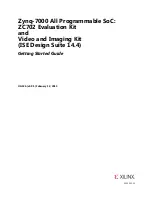C8051F120/1/2/3/4/5/6/7 C8051F130/1/2/3
156
Rev. 1.4
11.3.3. Interrupt Priorities
Each interrupt source can be individually programmed to one of two priority levels: low or high. A low prior-
ity interrupt service routine can be preempted by a high priority interrupt. A high priority interrupt cannot be
preempted. Each interrupt has an associated interrupt priority bit in an SFR (IP-EIP2) used to configure its
priority level. Low priority is the default. If two interrupts are recognized simultaneously, the interrupt with
the higher priority is serviced first. If both interrupts have the same priority level, a fixed priority order is
used to arbitrate, given in Table 11.4.
11.3.4. Interrupt Latency
Interrupt response time depends on the state of the CPU when the interrupt occurs. Pending interrupts are
sampled and priority decoded each system clock cycle. Therefore, the fastest possible response time is
5 system clock cycles: 1 clock cycle to detect the interrupt and 4 clock cycles to complete the LCALL to the
ISR. Additional clock cycles will be required if a cache miss occurs (see
for more details). If an interrupt is pending when a RETI is executed, a single instruc-
tion is executed before an LCALL is made to service the pending interrupt. Therefore, the maximum
response time for an interrupt (when no other interrupt is currently being serviced or the new interrupt is of
greater priority) is when the CPU is performing an RETI instruction followed by a DIV as the next instruc-
tion, and a cache miss event also occurs. If the CPU is executing an ISR for an interrupt with equal or
higher priority, the new interrupt will not be serviced until the current ISR completes, including the RETI
and following instruction.
Comparator 1 Rising Edge 0x006B
13
CP1RIF (CPT1CN.5)
Y
2
ECP1R
(EIE1.7)
PCP1F
(EIP1.7)
Timer 3
0x0073
14
TF3 (TMR3CN.7)
EXF3 (TMR3CN.6)
Y
1
ET3
(EIE2.0)
PT3
(EIP2.0)
ADC0 End of Conversion
0x007B
15
AD0INT (ADC0CN.5)
Y
0
EADC0
(EIE2.1)
PADC0
(EIP2.1)
Timer 4
0x0083
16
TF4 (TMR4CN.7)
EXF4 (TMR4CN.7)
Y
2
ET4
(EIE2.2)
PT4
(EIP2.2)
ADC2 Window Comparator 0x008B
17
AD2WINT
(ADC2CN.0)
Y
2
EWADC2
(EIE2.3)
PWADC2
(EIP2.3)
ADC2 End of Conversion
0x0093
18
AD2INT (ADC2CN.5)
Y
2
EADC2
(EIE2.4)
PADC2
(EIP2.4)
RESERVED
0x009B
19
N/A
N/A N/A N/A N/A
N/A
UART1
0x00A3
20
RI1 (SCON1.0)
TI1 (SCON1.1)
Y
1
ES1
(EIE2.6)
PS1
(EIP2.6)
Table 11.4. Interrupt Summary (Continued)
Interrupt Source
Interru
pt
Vector
Priority
Order
Pending Flags
Bit ad
dres
sa
ble
?
Cle
a
re
d by HW?
SFRP
AGE (SFRPGE
N
=
1)
Enable
Flag
Priority
Control
Summary of Contents for C8051F12 Series
Page 2: ...C8051F120 1 2 3 4 5 6 7 C8051F130 1 2 3 2 Rev 1 4 NOTES ...
Page 104: ...C8051F120 1 2 3 4 5 6 7 C8051F130 1 2 3 104 Rev 1 4 NOTES ...
Page 112: ...C8051F120 1 2 3 4 5 6 7 C8051F130 1 2 3 112 Rev 1 4 NOTES ...
Page 176: ...C8051F120 1 2 3 4 5 6 7 C8051F130 1 2 3 176 Rev 1 4 ...
Page 184: ...C8051F120 1 2 3 4 5 6 7 C8051F130 1 2 3 184 Rev 1 4 NOTES ...
Page 197: ...C8051F120 1 2 3 4 5 6 7 C8051F130 1 2 3 Rev 1 4 197 NOTES ...
Page 198: ...C8051F120 1 2 3 4 5 6 7 C8051F130 1 2 3 198 Rev 1 4 ...
Page 210: ...C8051F120 1 2 3 4 5 6 7 C8051F130 1 2 3 210 Rev 1 4 NOTES ...
Page 218: ...C8051F120 1 2 3 4 5 6 7 C8051F130 1 2 3 218 Rev 1 4 NOTES ...
Page 234: ...C8051F120 1 2 3 4 5 6 7 C8051F130 1 2 3 234 Rev 1 4 NOTES ...
Page 258: ...C8051F120 1 2 3 4 5 6 7 C8051F130 1 2 3 258 Rev 1 4 NOTES ...
Page 272: ...C8051F120 1 2 3 4 5 6 7 C8051F130 1 2 3 272 Rev 1 4 NOTES ...
Page 286: ...C8051F120 1 2 3 4 5 6 7 C8051F130 1 2 3 286 Rev 1 4 NOTES ...
Page 308: ...C8051F120 1 2 3 4 5 6 7 C8051F130 1 2 3 308 Rev 1 4 NOTES ...
Page 340: ...C8051F120 1 2 3 4 5 6 7 C8051F130 1 2 3 340 Rev 1 4 NOTES ...
Page 348: ...C8051F120 1 2 3 4 5 6 7 C8051F130 1 2 3 348 Rev 1 4 NOTES ...

















